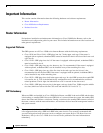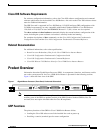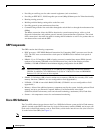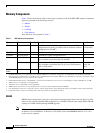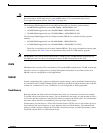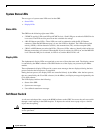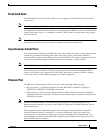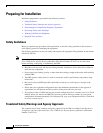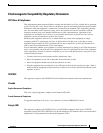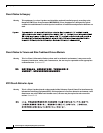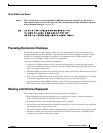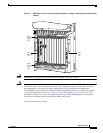
7
Memory Components
78-4339-09
Product Overview
Caution To prevent memory problems, DRAM DIMMs must be +3.3VDC, 60-nanosecond (ns) EDO devices.
Do not attempt to install other devices in the DIMM sockets. Cisco recommends that you use
Cisco-approved memory options. (See Table 14 on page 49.)
The following DRAM upgrade kits for the GRP and line cards are listed by product number:
• 64-MB DRAM upgrade kit (one 64-MB DIMM)—MEM-GRP/LC-64=
• 128-MB DRAM upgrade kit (one 128-MB DIMM)—MEM-GRP/LC-128=
• 256-MB DRAM upgrade kit (two 128-MB DIMMs)—MEM-GRP/LC-256=
The following DRAM upgrade kits for Product Number GRP-B= are available (listed by product
number):
• 256-MB DRAM upgrade kit (one 256-MB DIMM)—MEM-GRP-256=
• 512-MB DRAM upgrade kit (two 256-MB DIMMs)—MEM-GRP-512-UPG=
These kits are available only for Product Number GRP-B=. They are not compatible with any other
Cisco product. See Table 14 for all requirements related to the 512-MB memory upgrade.
Note MEM-GRP/LC-64= can be used to replace bank 1 or bank 2 in the 128-MB default configuration on
the GRP line card. Cisco does not recommend using a 64-MB configuration on this card.
SRAM
SRAM provides secondary CPU cache memory. The standard GRP configuration is 512 KB. Its principal
function is to act as a staging area for routing table updates information to and from the line cards.
SRAM is not user configurable or field upgradeable.
NVRAM
System configuration files, software configuration register settings, and environmental monitoring logs
are contained in the 512-KB NVRAM, which is backed up with built-in lithium batteries that retain the
contents for a minimum of 5 years. NVRAM is not user configurable or field-upgradeable.
Flash Memory
Both the onboard and Flash card-based Flash memory allow you to remotely load and store multiple
Cisco IOS software and microcode images. You can download a new image over the network or from a
local server and then add the new image to Flash memory or replace the existing files. You can then boot
the routers either manually or automatically from any of the stored images.
Flash memory also functions as a Trivial File Transfer Protocol (TFTP) server to allow other servers to
boot remotely from stored images or to copy them into their own Flash memory. The onboard Flash
memory (called bootflash) contains the Cisco IOS software boot image, and the Flash memory card or
Flash disk contains the Cisco IOS software image.




